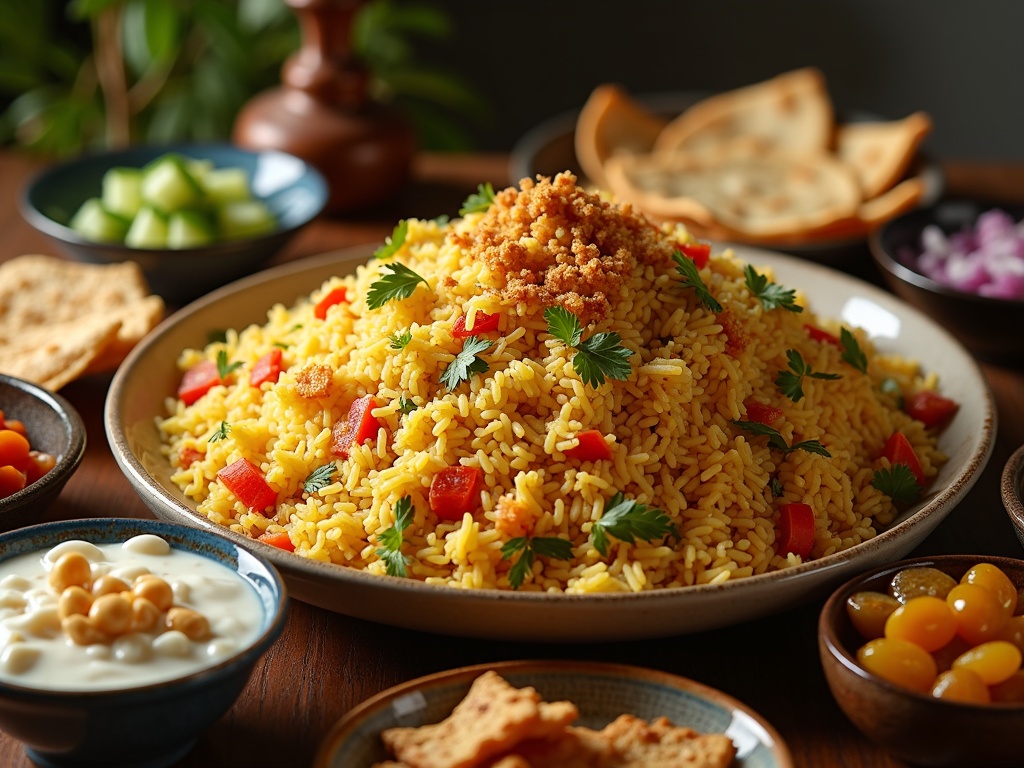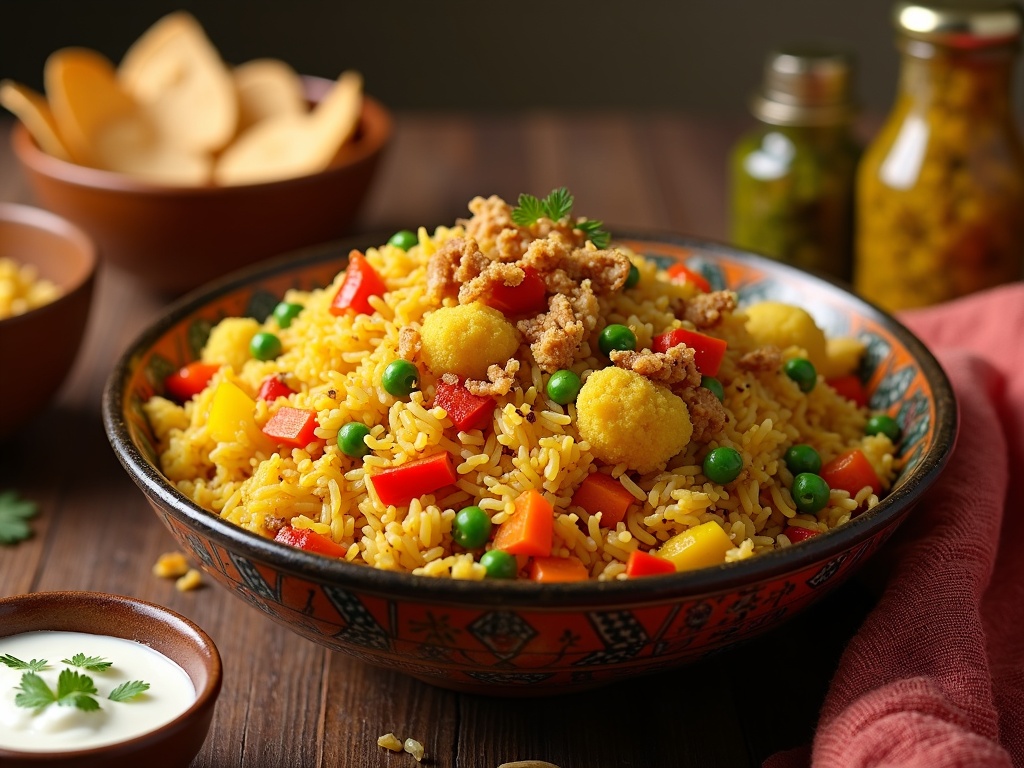Veg pulao is a nutritionally balanced, aromatic rice dish that blends basmati rice with seasonal vegetables and warming spices. It serves as a lighter option compared to biryani at only 200 calories per serving. This adaptable Indian comfort food takes less than 40 minutes to prepare, making it perfect for daily meals and special gatherings when paired with complementary sides.
Find In This Article
Key Takeaways
- Veg pulao offers a complete nutritional profile through its colorful vegetables, with carrots providing vitamin A, green peas adding protein and fiber, and bell peppers delivering vitamin C and antioxidants.
- The dish gets its distinctive flavor from whole spices like cumin seeds, bay leaves, cinnamon, cardamom pods, and cloves, which are tempered in hot oil or ghee at the beginning of cooking.
- The cooking process involves pre-soaking basmati rice, sautéing spices and vegetables, and using a water-to-rice ratio of 1.5:1 for perfectly fluffy grains.
- Unlike biryani’s layering technique, pulao combines all ingredients for a more uniform flavor profile throughout the dish.
- For a complete meal experience, serve veg pulao with cooling raita, crispy papads, and Indian pickles, or garnish with fried onions, toasted cashews, and golden raisins.
A Flavorful One-Pot Indian Rice Dish
Veg pulao is my absolute favorite comfort food from Indian cuisine. I’ve perfected this aromatic rice dish over the years, combining fragrant basmati rice with seasonal vegetables and warming spices. It’s a versatile meal that serves as both a satisfying main course or a complementary side dish.
Unlike its richer cousin vegetable biryani, veg pulao offers a lighter option without sacrificing flavor. A standard cup serving contains approximately 200 calories, with 4g protein, 30g carbs, and 5g fat. That’s significantly lighter than biryani, which typically packs 400-600 calories per serving. This makes pulao an excellent choice for everyday meals or when I’m watching my calorie intake.
Nutritional Powerhouse
The beauty of traditional pulao recipes lies in their nutritional balance. Each colorful vegetable adds its own health benefits:
- Carrots provide vitamin A for eye health and immune function
- Green peas offer protein and fiber to keep you feeling full
- Bell peppers deliver vitamin C and antioxidants
- Cauliflower adds satisfying texture and vitamin K
- Potatoes contribute potassium and essential carbohydrates
These vegetables aren’t just for flavor—they transform a simple rice dish into a complete meal. I appreciate how the nutrients complement each other, creating a dish that’s as nourishing as it is delicious.
From Pot to Plate in 40 Minutes
What makes veg pulao particularly appealing is its simplicity. Unlike elaborate rice dishes that require hours of preparation, I can have this on the table in just 30-40 minutes from start to finish. The cooking process follows a straightforward method:
First, I sauté whole spices in ghee or oil to release their essential oils. Then I add chopped vegetables and rice, stirring to coat each grain with the fragrant spice mixture. After adding water or vegetable broth, the entire pot simmers until the rice is tender and has absorbed all the liquid.
The core components that give Indian rice dishes their characteristic flavor include aromatic basmati rice, fresh seasonal vegetables, and a carefully balanced spice blend. Traditional pulao spices typically include cumin seeds, bay leaves, cinnamon, cardamom pods, and cloves.
For a flavor variation, I sometimes take inspiration from Chinese fried rice techniques by adding soy sauce and ginger. Or I might prepare it more like pilau rice with a simpler spice profile when serving it alongside curries.
The versatility of veg pulao extends to the vegetables you can include. While traditional recipes call for carrots, peas, and beans, I often customize based on what’s in season or available in my refrigerator. This adaptability makes it perfect for using up leftover vegetables.
What distinguishes vegetable biryani from pulao is the layering technique and more complex preparation in biryani. Pulao, by contrast, mixes all ingredients together for a more uniform flavor profile throughout the dish.
The secret to perfect pulao lies in the ratio of rice to water and the patience to let it cook undisturbed. This allows the rice to absorb all the flavors while maintaining its distinct grain structure without becoming mushy.
Essential Ingredients That Make It Special
The true magic of a delicious vegetable pulao recipe lies in its ingredients. I’ve found that selecting the right components makes all the difference between an ordinary rice dish and an extraordinary culinary experience.
The Foundation: Rice and Vegetables
Basmati rice forms the backbone of any authentic pulao. I always soak 1 cup of basmati for 30 minutes before cooking—this crucial step allows the grains to absorb moisture, resulting in perfectly separated, fluffy rice once cooked. Unlike vegetable biryani, which requires more complex preparation, pulao benefits from this simple pre-soaking technique.
The vegetable selection brings color, texture, and nutrition to the dish. I typically use 1.5 cups of mixed vegetables, including:
- Carrots for sweetness and vibrant orange color
- Green peas for pop and freshness
- Bell peppers for crunch and visual appeal
- Green beans for texture
- Potatoes for heartiness and body
What I love about fragrant rice dishes is their flexibility—you can easily substitute vegetables based on seasonal availability without compromising the essence of the dish.
Aromatic Whole Spices
The distinctive flavor profile of pulao comes from its masterful use of whole spices. Unlike Chinese fried rice which relies on sauces and seasonings, pulao gets its character from:
- 1 bay leaf—releasing subtle herbal notes
- 2-3 cardamom pods—adding sweet, floral complexity
- 4-5 cloves—contributing warm, pungent undertones
- 1 cinnamon stick—imparting gentle sweetness and aroma
These spices are typically tempered in hot oil or ghee at the beginning of cooking, releasing their essential oils into the fat. This creates a fragrant base that permeates every grain of rice.
2 tablespoons each of freshly chopped cilantro and mint provide brightness and freshness. The herbs are best added in two stages—half during cooking and half as a final garnish—to create layers of flavor.
For the cooking medium, I prefer using 2 tablespoons of ghee for its rich, nutty flavor, though vegetable oil works well for a lighter version. The choice between traditional pilau and pulao often comes down to these subtle ingredient differences.
Salt is essential, adjusted to taste, while green chilies are optional for those who enjoy a touch of heat. The beauty of these ingredients lies in their harmonious integration—no single element overpowers the others.
When preparing vegetable biryani variants, you might use many of the same ingredients but in different proportions and preparation methods. Pulao’s charm comes from its elegant simplicity, letting each ingredient shine through in a balanced, cohesive dish.
By respecting these essential ingredients and understanding their purpose, I’ve found that even home cooks can create restaurant-quality pulao that delights the senses and satisfies the soul.
Mastering the Perfect Veg Pulao
Cooking a delicious vegetable pulao isn’t complicated once you understand the basic techniques. I’ve perfected this dish over the years, and the secret lies in a few simple steps that elevate this humble rice dish to something truly special.
The Cooking Process
I always start by heating ghee or oil in a heavy-bottomed pot. Once hot, I add whole spices like cardamom, cloves, and cinnamon sticks, letting them sizzle for about 30 seconds until their aromatics fill my kitchen. This fragrant foundation is crucial – it infuses the entire dish with flavor right from the start.
Next comes the vegetable selection. I add my chosen vegetables to the spice-infused oil, sautéing them just until they start to soften. The trick is not to overcook them at this stage since they’ll continue cooking with the rice. Once the vegetables are partially cooked, I add pre-soaked rice, stirring gently to coat each grain with the flavored oil.
The water ratio is critical for perfect pilau rice – I use 1.5 cups of water for every cup of rice. This creates the ideal texture, neither too mushy nor too dry.
Cooking Methods Compared
You can choose between pressure cooking or the traditional stovetop method:
- Pressure cooking: Quick and efficient, requiring just 2 whistles on medium heat
- Stovetop method: Takes longer but allows for better flavor development as the rice slowly absorbs the aromatic water
- Dum method: Similar to vegetable biryani, using a sealed pot with a tight lid
The most overlooked step is the resting period. After cooking, I always let my pulao rest for 5-10 minutes before fluffing with a fork. This patience makes all the difference, allowing the rice to finish cooking in its steam and helping the flavors settle.
Unlike Chinese fried rice or jeera rice, pulao benefits from this resting time to achieve its characteristic separate, fluffy grains. The extra few minutes of waiting transforms good pulao into great pulao.
I’ve found that each cooking method has its place. When I’m short on time, the pressure cooker delivers consistent results quickly. For weekend cooking when I can take my time, the stovetop method lets me monitor the texture and gives a slightly more developed flavor profile that reminds me of a simpler version of veg biryani.
Elevate Your Meal with Perfect Pairings
The secret to serving an impressive vegetable pulao lies in its accompaniments. I’ve found that the right sides can transform this rice dish from merely satisfying to truly memorable.
Complementary Side Dishes
A cooling raita is my top recommendation to balance the aromatic pulao rice. This yogurt-based side contains finely chopped vegetables like cucumber, tomato, and onion, creating a refreshing contrast to the warm spices in the pulao. The creamy texture perfectly complements the fluffy grains of the jeera-infused rice.
Crispy papads add that essential textural element to your meal. These thin, crunchy lentil wafers can be roasted or fried and served alongside the pulao, offering a delightful crunch against the soft rice.
For a burst of flavor, include some Indian pickles on the side. Their tangy, spicy profile cuts through the richness of the vegetable rice and adds complexity to each bite.
I like to finish my pulao with these garnishes for extra flavor and visual appeal:
- Fried onions for a sweet, caramelized taste
- Toasted cashews for nutty richness
- Golden raisins for subtle sweetness
The best part about vegetable pulao is its versatility in storage. It keeps beautifully in the refrigerator for 3-4 days, making it perfect for meal prep. The flavors often deepen overnight, creating an even tastier lunch the next day.
This dish transitions effortlessly between everyday dinners and special occasions. For regular meals, I serve it simply with raita, while for gatherings, I’ll present it with the full array of sides and garnishes. The fragrant rice dish makes an impressive centerpiece that satisfies both vegetarians and meat-eaters alike.

Sources:
Indian Cooking: A Practical Guide
Nutrition Journal: Calories in Indian Dishes
The Art of Indian Vegetarian Cooking
Indian Biryani vs Pulao: Understanding the Differences

